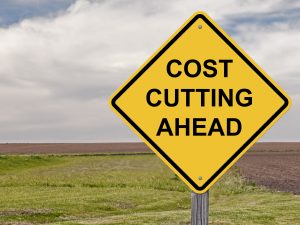Nine ways to cut costs in your business
 Too often businesses emphasize increasing sales as the only way to boost profits. Cost-cutting, when done selectively and intelligently, can be a faster way to higher profits. “Trimming the fat” should continually be on every business owner’s or manager’s mind, and a serious cost-cutting review should be conducted every year or two.
Too often businesses emphasize increasing sales as the only way to boost profits. Cost-cutting, when done selectively and intelligently, can be a faster way to higher profits. “Trimming the fat” should continually be on every business owner’s or manager’s mind, and a serious cost-cutting review should be conducted every year or two.
Here are nine ways you may be able to cut costs in your business.
1. Look at gross profit margins. If the margin has been deteriorating, find out why. Determine if increases in direct costs can be passed along to the customer. Analyze the product to see if it can be reformulated or redesigned for cost savings.
If you sell a number of different products, determine their individual gross profit margins and their mix. Give particular attention to low-margin products to see if it’s still worthwhile to carry them.
2. Payroll costs are a major item in most businesses. Perhaps a more efficient plant layout or automation would result in reduced labor needs. The initial investment may be costly, but more than offset by future payroll savings. Consider the use of temporary employees and subcontractors if your business is subject to seasonal variations.
Payroll-related costs are fertile areas for cost reduction. Fringe benefits can easily amount to 25-50% of direct payroll. Review employee classifications for workers’ compensation insurance. Improperly classified workers can be costing you significant premiums. Review group insurance programs. Solicit bids for the programs every three years. Consider higher deductibles as a means to lower premiums.
3. Review telephone and postage costs. Are all telephone calls necessary? Is the telephone being used effectively? Can money be saved by alternate shipping and receiving carriers?
4. Review credit policies. The longer it takes to get paid, the greater the risk of loss. The 80/20 rule states that 80% of your revenues are generated by 20% of your customers. If this is the case, it may be wise to review the other 80% of your customers to see if you can continue to serve them cost-effectively. Otherwise, your time will be better spent soliciting new customers.
5. Analyze inventory levels. Determine if any obsolete inventory can be reworked or sold for salvage.
6. Review fixed assets. Consider disposing of excess machinery and equipment. Determine whether it would be better to buy or lease major assets, especially those subject to rapid technological change and those assets used infrequently.
7. Review purchasing policies and costs of supplies, products, or raw materials. Compare prices of other suppliers. Switch suppliers where appropriate, or renegotiate for better prices with your current suppliers.
8. Enlist the aid of employees by soliciting suggestions on cost reduction. Many companies have generated significant savings using this approach. To encourage participation, consider implementing a bonus program based on a percentage of costs saved. Be wary of “quick fixes” that will have no impact, or worse, prove costly in the long run.
9. Review your expenses on a regular basis; don’t wait until a financial crisis develops. Avoid the temptation to make across-the-board cuts, because rarely do all areas of the company contribute equally to its success.
There may be other cost-cutting strategies that would improve the profitability of your business. If you would like to discuss cost-cutting or other business concerns you have, please contact a Dugan & Lopatka professional at info@duganlopatka.com or (630) 665-4440.
